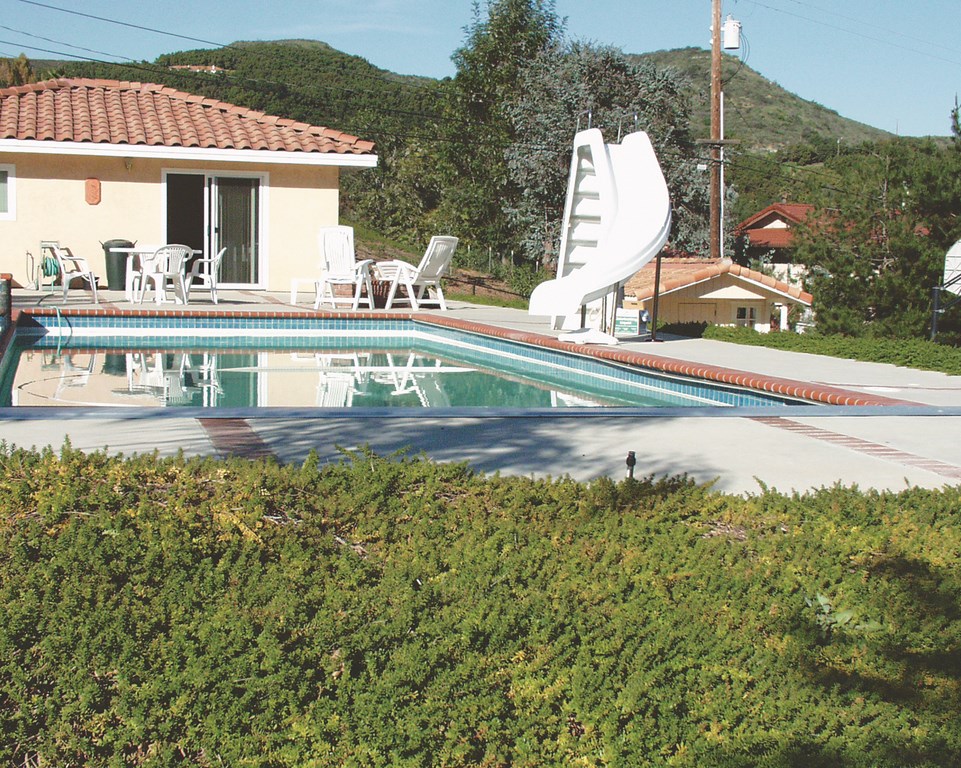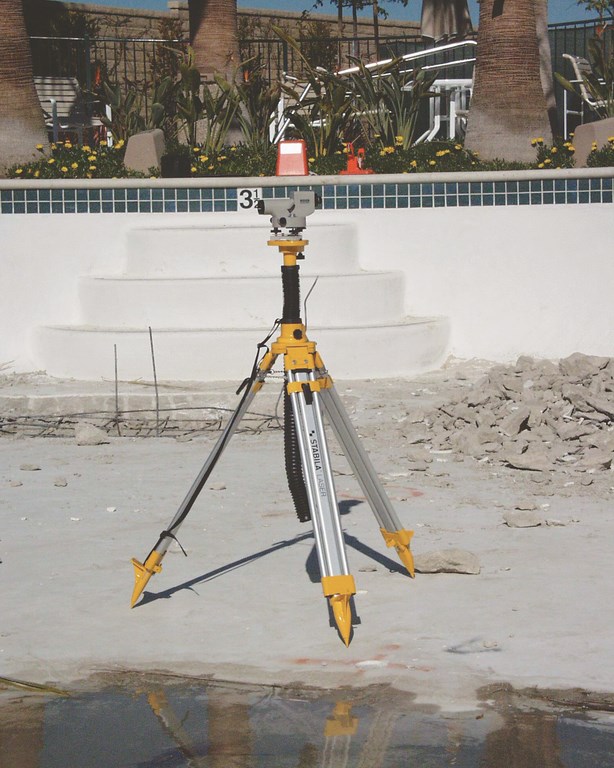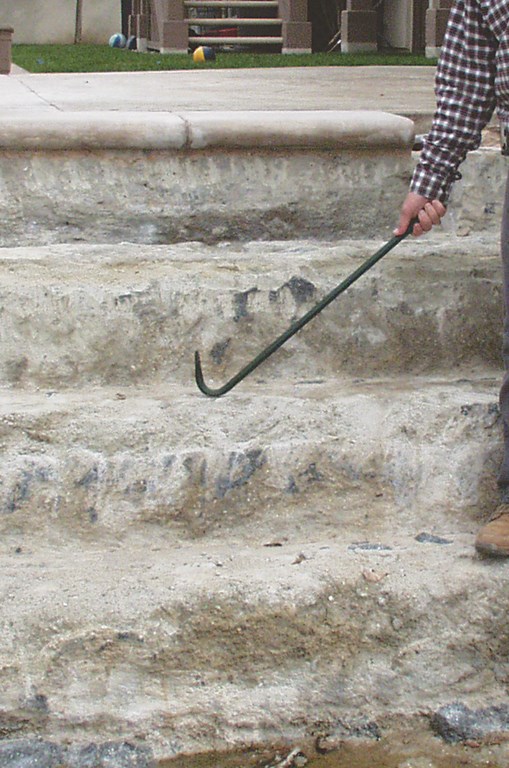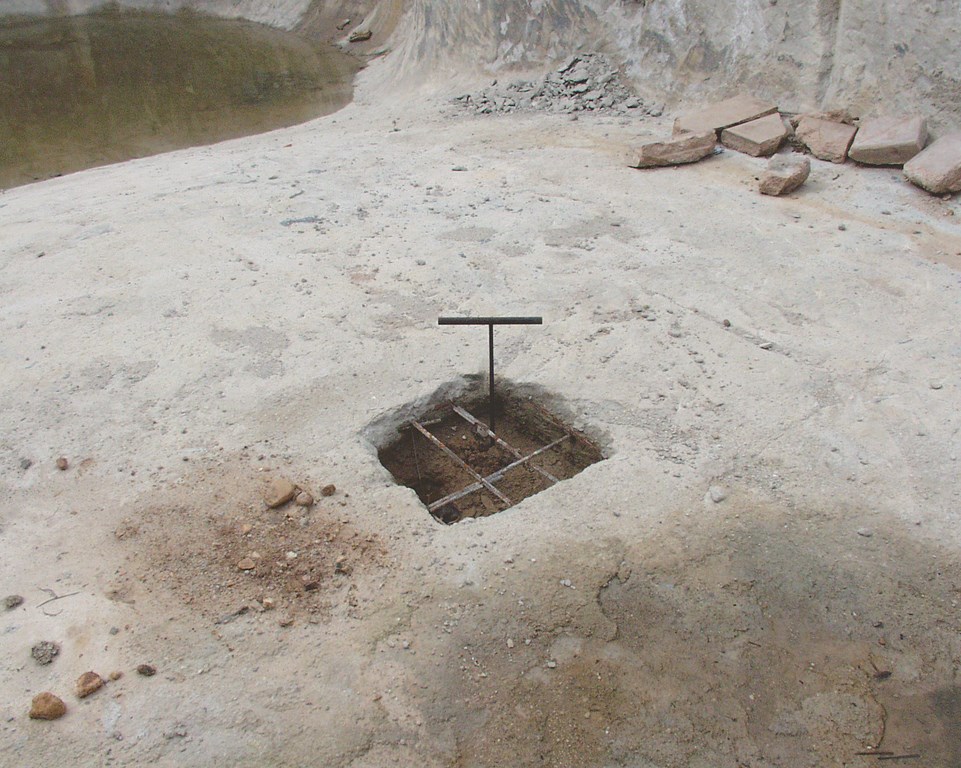When Pools Crack
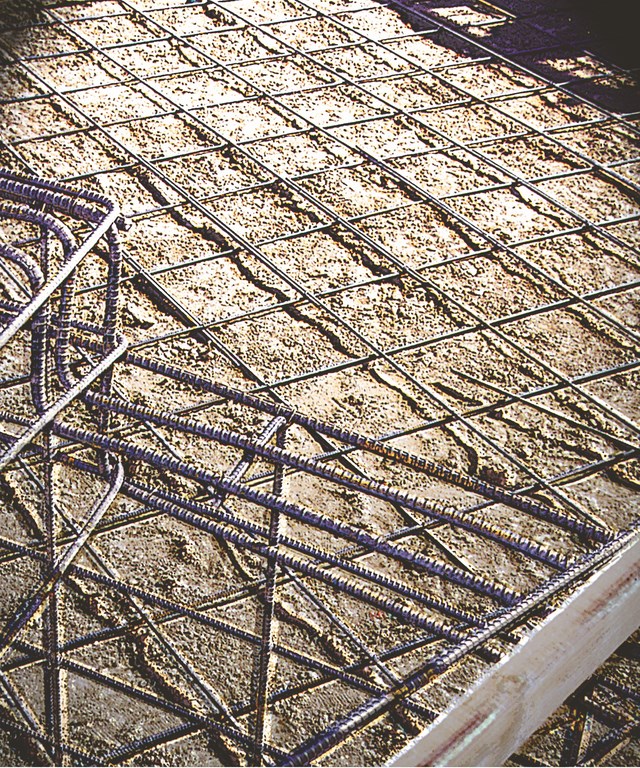
Even though many swimming pools look similar in lots of fundamental ways, every one of them is actually quite unique.
From soil and groundwater conditions or the specifics of their structural designs to the ways in which they have been installed, water-containing vessels of all shapes, types and sizes are, in fact, subject to a wide array of site- and workmanship-specific variables that can influence the way their concrete shells will perform through the years.
When a watershape cracks, any number of things might have gone wrong. To the owner of a watershape, of course, such cracking is obviously a source of concern. The fix is often expensive, and it’s not at all unusual for contractors to defend their work as a means of avoiding the necessity of paying to remedy the situation.
This can leave the owner in a very difficult position in which experts must be called in to determine the true cause of the problem – and then he or she might be left alone to pressure the contractor who installed the vessel to take responsibility and foot what can be a sizable bill for setting things straight.
When experts get involved, the forensic process can vary greatly depending on the situation. Sometimes the problem is readily apparent with a brief visual inspection; other times, however, determining a cause can require a detailed investigation that can itself be costly. But let’s take a look at my experience in such processes and see how such hassles might be avoided in the first place.
FAILURE FORENSICS
If there’s an upside to watershape failures, it is first of all that these are not generally life-threatening defects and usually do end up being resolved one way or another, even if it takes months and the help of arbitrators. Some contractors and homeowners do a better job than others of keeping that basic point in mind.
Another benefit is that by studying our failures, we as an industry are better able to accommodate the variables found in what we do and advance our knowledge in such a way that we can avoid future problems.
As an engineer specializing in watershapes, I’ve found through my own involvement in these situations that there are often two basic factors pointing to structural problems – one being soil conditions, the other being workmanship. A key observation is that these two factors are absolutely interrelated in that the soil conditions invariably dictate the specifics of the structure.
A swimming pool, which is the type of vessel I’ll use throughout this article to illustrate the issues involved in watershape failures, can be placed successfully in virtually any type of soil so long as it has been designed properly and installed per a structural design that takes soil conditions into account.
| With the water lowered beneath the tile line, it’s obvious that this pool has shifted out of level. The upper left corner is higher than the upper right corner, and it’s easy to see the narrowing band of white as the eye moves along the right side of the vessel. While the damage is clear, the causes aren’t always obvious and call for investigation by a professional armed with knowledge and a proper set of forensic tools. |
But where workmanship issues can be quite straightforward because there are recognized standards and also because problems are often apparent through a simple physical inspection, soils issues can, by contrast, be tricky in that pool contractors are not required to be geologists. Nor is a soils report required for each and every job: In newer residential developments, for example, it’s presumed that the soil conditions are uniform.
There’s also the plain fact that even in situations where a geologist has dug “test pits,” soils reports don’t always catch everything that’s going on in the ground. What this means is that there are gray areas in some situations, so anyone examining a failed structure must gain access to the plans, contracts, soils reports, inspection certificates and any other existing documentation to get to the bottom of things.
More important, it also means that a pool contractor needs to be knowledgeable enough to be on the lookout for problems as the project moves forward. Often (but not always), variations in conditions that might lead to problems will be openly visible, for instance, when the hole is excavated for a pool. That’s the case with uncompacted fill, for example, which may have a different color, texture and appearance than will properly compacted or otherwise reliable soil.
Many contractors I know are experienced enough to see problems during excavation and can raise the issue with the homeowner before construction proceeds. Although such a revelation about soil conditions may result in a structural redesign and typically in increased costs, it’s far better to avoid potential problems up front.
And make no mistake: I’m not arguing that contractors should act like geologists. Instead, my point is that if you see something that looks questionable, it’s time to stop working, step back and call in experts to help you make decisions based on firm technical data. Guesswork and “rules of thumb” will only lead to trouble.
ON-SITE EXAMINATION
When failures do occur, there are so many possible variables involved in a pool’s predicament that it is important for the investigator to take an extremely systematic approach to examining the site. In my case, that boils down to a straightforward mental checklist.
If a pool has cracked, for example, the first thing I do is compare the actual waterline with the grout lines in the waterline tile to see if the structure is out of level or has rotated. Because the actual waterline is always level and because the swimming pool tile is supposed to be level, you can examine where the water touches the tile and tell whether part of the pool has become raised or lowered. (If there’s no water in the pool, I use an engineer’s level on a tripod and compare the levels at various points around the pool. A laser or water level will also work.)
| One of the ways to tell what’s going on with a pool shell involves inspecting the mastic joints that separate the coping from the surrounding deck. If the joint is compressed (as above), I look for an uphill slope that might be creeping and pressing the deck up against the joint. By contrast, if the joint has widened, there may be movement in a downhill slope that is carrying the deck away from the pool. |
The next thing I look at is the location and orientation of any cracks. If, for example, one end of the pool has settled, you’ll typically see a vertical crack that’s wider at the top (near the bond beam). From this, you can make a reliable assumption that the pool shell has lost support beneath the end that has settled and that the hinge point has emanated as a crack.
Obviously, if a pool has become out of level, part of the pool will be higher than the rest of it. So how can you tell if the higher portion of the pool has risen or if the lower portion has settled? That’s a determination that takes years of experience and is based on the location and orientation of the cracking as well as other evidence observed at the site.
If, for example, you see a crack that emanates from the floor or near the bottom of the wall, then you start to get the impression that the pool may have been lifted up by expansive soil or hydrostatic pressure.
I’m often called to sites where I find a failed pool that has been built behind a retaining wall. If the retaining wall is downslope of the pool and has a footing that’s lower than the bottom of the pool, I immediately suspect that part of the pool was built over reliable soil and that part was put on fill. This is what is known as a cut/fill transition, and building on one of them generally spells trouble.
| With the pool empty, an engineer’s level will quickly tell you how far out of level the pool has become and in what areas. (A laser or water level will also do the trick.) This offers many clues to the source of the problem that can be confirmed by additional exploration of the shell, any cracking that may be apparent and the pool’s surroundings. |
Slope creep is another extremely common cause of a cracked or rotated pool. When vessels are located near the top of unretained descending slopes, frequently the surface of the slope is pulled slowly downward by gravity, leaving the vessel unsupported. In these situations, it is likely that there will be visual evidence of the slope’s movement, such as leaning fences or rotated surface improvements near the top of the slope.
I also explore issues of pool movement or rotation by inspecting the gaps in expansion or mastic joints that surround coping stones. If, for example, slope creep is influencing the pool shell, I’m likely to see mastic joints near the top of the slope that are spreading apart or shearing as a result of lateral movement. In the case of movement of a slope uphill from a pool, I’ll usually find compressed joints on the uphill side – that is, the mastic material will bulge out of the top of joint as the movement of the soil compresses adjoining decking slabs.
The presence of the high water tables frequently found in low-lying areas is another possible cause of structural failure. In extreme cases, empty pools will lift or float out of the ground. A word of caution: It’s not uncommon to float an empty pool that has been placed at the bottom of a nearby ascending slope. Water moving through bedding planes and down the slope saturates the area around the shell and can result in spectacular failures. It’s quite a shock to see a floated pool in a hillside area, miles from known high-water-table areas!
There are, of course, less-dramatic examples of groundwater-related problems, as when it intrudes into expansive soils and causes lateral movement as well as upward pressure when the soil swells, loses friction and forms slip planes that makes things move.
SIMPLE TOOLS
When I inspect failed pools, I carry a couple of very important tools with me. Both are about as low-tech as can be, but they can be extraordinarily helpful in pinpointing problems.
The first is a crow bar. When I see cracking in the shell or on the steps of a pool, I’ll just tap the plaster surface firmly and listen carefully to the sound. When an area is structurally sound, the bar will make a solid sound with a ring to it. By contrast, when I tap an area that is hollow (such as damaged plaster or delaminated gunite), there’s a distinctly hollow sound. This is a simple technique that gives me important information about where the problems are beneath a pool’s surface.
Another favorite tool is a probe – a simple, straight, narrow metal bar with a “T” at one end for a handle and a point at the other end. Soil technicians are frequently seen using this tool when examining the bottom of pool excavations. Under firm pressure, the pointed end of the probe should not penetrate competent soil. If penetration into the subgrade soil is easy after portions of the pool shell have been removed, it’s a clear sign that the underlying soil is the likely culprit in the vessel’s structural distress. If that penetration is not easy, the soil is much more likely to be suitable.
| One of my tools is a crowbar. Where I see cracks, I tap the plaster surface firmly and listen. When an area is structurally sound, I hear a solid ring. If the area is hollow, there’s a distinctly hollow thud. This simple technique tells me a lot about what’s going on beneath a pool’s surface. |
(For contractors, this exercise would be particularly useful during excavation when soil differences are spotted. Keep in mind that when the probe won’t penetrate the pool’s subgrade soil it’s only one indicator, not a guarantee that the soil is suitable for the structure. By contrast, if the probe easily penetrates the subgrade soil, you can rest assured that you’re working on material that likely will not support a heavy concrete structure such as a pool.
(It’s important to remember that these tools and techniques are – in no way, shape or form – any substitute for a certified soils reports or proper engineering. Just the same, they can be very helpful in helping to avoid problems down the line.)
In general, my informal observations on site with my crowbar and probe will almost always lead to an examination of a soils report and/or the grading plan for the home or subdivision. Often times, I will spot cut/fill transitions or other soil conditions that might be congruent with movement of the pool shell. I might also see the presence of bedding planes that might transmit groundwater through the area or observe soil types that may result in slope creep.
As mentioned above, mass-graded housing subdivisions will often have soils reports that apply to the entire area. In these situations, you can generally count on the reliability of the soil, but I’ve also seen situations where the grading and compaction wasn’t properly supervised and problems have arisen in specific areas. Again, the best place to catch those sorts of problems is during construction -and especially during excavation.
Because there is no certainty without a detailed soils report reflecting conditions on a specific plot of land, I always tell builders to watch for soils that just don’t look quite right. Excavators can be particularly helpful here and should be reminded to inform the pool contractor if they encounter any significant differences in the texture or firmness of the soil as they remove it.
If available, construction photos or even some before-and-after photos of the site can be helpful in determining the cause of a subsequent problem. Photographs taken of slopes before construction, of the excavation process or during construction of retaining walls are particularly valuable when it comes to understanding the causes of failure.
WORKMANSHIP ISSUES
For all of the variables introduced by soils conditions and groundwater intrusion, there are times when the real problem leading to a cracked shell is a failure of workmanship. Improper gunite or shotcrete application – especially in the form of inadequate coverage of reinforcing steel – is probably the most common of these issues.
One of the things I look for when I suspect such failures is what I call “reflective cracking.” This is the series of cracks that sometimes forms in the pattern of the reinforcing steel in the concrete shell, and I’ve seen it in a lot in spa dams and other freestanding walls, including vanishing-edge weir walls. In these cases, the gunite has not properly encased the steel, which can happen if the reinforcement is out of position for some reason or if the thickness of the gunite applied over the reinforcement is insufficient.
Another common cause of failure is steel that hasn’t been adequately tied. When gunite or shotcrete is applied, material comes out of the hose at a high velocity and hits the reinforcing steel, causing it to vibrate. If the steel has not been properly tied, this vibration can lead to expanses of shell with incomplete encasement. The result is effectively an unreinforced shell that will be susceptible to reflective cracking.
| A probe – that is, a long bar pointed at one end with a “T” handle at the other – is used to check on the condition of the soil around a shell. If the probe enters the soil easily, it is unlikely that the soil is supporting the shell adequately. If the soil resists, the soil may be competent – meaning we need to find the source of the problem elsewhere. |
Another common workmanship failure involves installation of decking that lacks proper expansion joints. This can lead to extensive cracking in the decking because the decks can’t move freely with any expansion of the soil. We also see problems with the expansion joints that separate the coping from the deck: If they’re not properly installed pressure against the bond beam from temperature expansion of the deck will often lead to horizontal cracks at the tile line.
There are numerous other workmanship issues – skimmer installation, for instance, or the interfacing of shells with cantilevered decks or the installation of artificial or real rockwork – that can come into play. The potential problems here are so substantial that discussion of them will have to wait for another article.
The most important point to take away from this discussion now is that each setting, each pool and each failure is a little bit different. This can sometimes lead to frustration with the inspection process, because there is strong desire for a clear-cut resolution and an agreed-upon course of remediation.
In California, which is where I do much of my work, it is fortunate that there are rules governing these investigations that allow me to render my opinions based on established standards. Sometimes, the homeowner or the contractor who is left to foot the cost of rehabilitating a pool will disagree with my findings, however, and will end up taking the matter to attorneys and into court.
I know from my own experience as an expert witness that it’s tough to predict how things will go in court or forecast how a jury will respond to the information presented during a trial. If you honestly think the homeowner or a developer or someone else should bear the responsibility for the failure, press on. If not, be aware as a contractor that once you enter the legal realm, you might just end up losing more than you would have had you simply bitten the bullet in the first place.
Better yet, I suggest paying attention to details of soils, groundwater or workmanship in the first place – and avoiding problems completely.
Ron Lacher is president of Pool Engineering Inc., in Anaheim, Calif. A licensed civil engineer, he spent the first ten years of his career managing large-scale construction projects for a variety of governmental agencies before becoming a pool builder in Southern California. In 1992, Lacher founded Pool Engineering, which specializes in developing structural and engineering plans. Since then, the firm has provided structural documents and details for thousands of residential and commercial swimming pools. He regularly serves as a field expert for California’s Contractor State License Board, insurance companies, homeowners and pool-construction companies.











